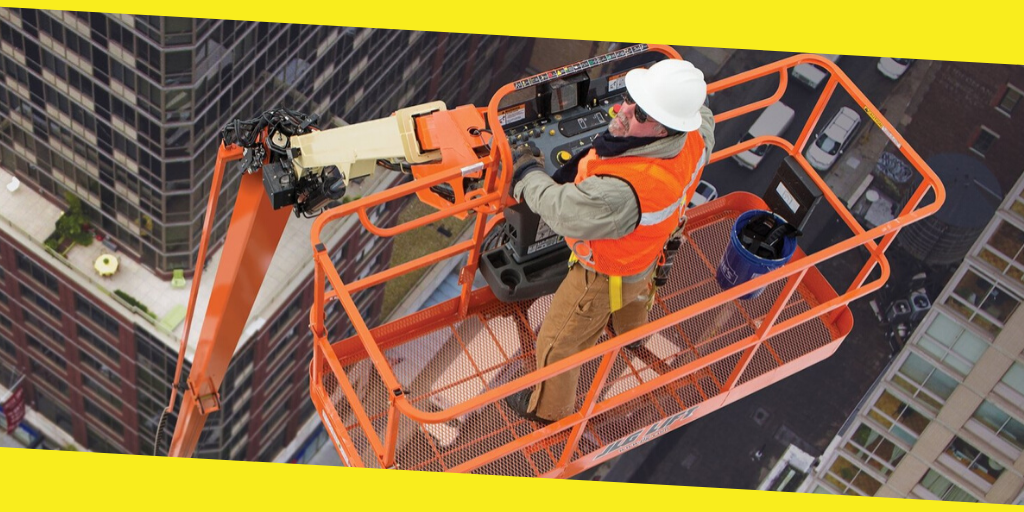7 Aerial Lift Safety Tips You Should Know
This post was last updated on June 15th, 2023

Aerial lift operation is a necessary part of rooftop contracting and maintenance work. It is a vehicle-mounted device with adjustable platform that is used to elevate the personnel.
Also known as scissor lift, it is an ideal piece of machinery for the aerial projects where scaffolding isn’t the best option.
In most cases, scaffolding isn’t used for aerial projects because it’s unsafe or practical. It’s designed to be used on solid ground and can collapse or become unstable when not properly secured. Additionally, it can be challenging to set up and take down, aside from being a tripping hazard.
This is why using scaffolding for aerial projects often results in serious accidents. If you or someone you know happens to be a victim of one, consider hiring a scaffolding accidents attorney. They can help you recover compensation for your injury. Still, if you can avoid this unfortunate situation, the better.
However, while using any of the aerial lift device it is essential to incorporate safety. Here, we have put together seven you should follow while operating scissor lift-
Check Every Part Of The Lift Before Operating
The first thing to do before using an aerial lift is to inspect every single part of it. Check the vehicle for fluid levels, including fuel, coolant, and oil. Some other things to check include wheels, charger, light, tires and backup alarms.
Check if all the systems, including electrical, air and electrical system, as well as the emergency controls are working properly. See if there are any missing parts or unreadable instructional placards, and get them repaired.
Before loading any supplies or personnel, make sure that the lift is functioning properly.
Inspect The Work Area To Find Out Any Potential Hazards
As important is the safe machinery, so is the safe work zone. If you are working indoors, examine if the ceiling is at an adequate height. Also, check the floor or surrounding area for bumps, unstable surfaces or other obstructions that may cause safety hazards such as:
- Tip Over
- Electrocutions
- Entanglement
- Personnel falling
- Overhead Obstructions
Make sure that all the holes, ditches, drop-offs, debris, etc are cleaned properly. Take a note of the overhead communication cables or electrical lines. Winds or other severe weather conditions can cause major hazards and endanger the lives of the employees.
Besides, you should know how to operate the aerial lift properly and safety precautions to be taken before or after the operation.
For this, you can register yourself for the online training from a reputable organization.
Be Attentive While Working Near Wires
Whether the wires or other conductors appear insulated or not, it is better to consider them energized. If you can’t avoid working in the area surrounded by power lines, keep the vehicle at least 10 feet away so that any accidental damage can be avoided.
Working near wires puts you close to several electrical hazards. For example, you can receive a massive electric shock if you so much as touch a live wire on accident. This can be fatal, so it’s essential to be aware of the surroundings and take the necessary steps to avoid contact.
Aside from electrocution, working near wires exposes you to the risk of fire and other injuries. If you’re careless, you can cut yourself on a sharp cable or trip and fall while working on a ladder. To better manage these risks, always stick to best practices when dealing with electrical wires for your aerial projects.
Avoid Sitting, Leaning Or Climbing On The Edge Of Platform
Guardrails or railings on the boundaries of an aerial lift are meant to protect the workers. So, it shouldn’t be used for sitting, climbing or reaching something that is slightly out of reach. Instead, lower down the lift and move the machine some feet away rather than inviting an injury.
Never Put Scaffold On The Aerial Lift
Due to the shape, potential height and ability to extend vertically, a scissor lift can cause problems if not handled properly. For example, scaffolding on aerial lift is an irresponsible practice. Regardless of the fact that scaffold falls under the capacity limits, if you put in on the scissor lift, it can increase the risk of accidents.
It’s best to take a good scissor lift course to know what and what not to do for your safety during aerial projects.
Don’t Move The Lift Upright
Before moving a scissor lift, it is essential to completely lower it. If you move the lift even when it is slightly elevated, the lift can tip over. Therefore before relocating the lift, check its level and then move it.
Likewise, never use a boom lift for carrying heavy objects or supplies. Since it is meant to lift people, overloading it with bulky things can put your entire team at risk.
Wear A Restraining Belt For Your Safety
It is likely to fall out of a lift, especially in a boom lift, as it moves back and forth, up and down. To save yourself from any mishap, put over a harness or belt so that you are secured before moving the lift.
A restraining belt is a typical piece of personal protective equipment (PPE) worn around the waist and secured to an anchor point. The latter can be a fixed object like a beam or ladder or a mobile object like a harness. If you lose your footing, the belt will prevent you from falling.
Also, clear the surrounding area of the other equipment that may cause any accidents.
Keep these safety tips handy for the next time you operate boom or scissor lifts. Adequate pre-inspection, training from a good organization, precautionary measures are the key ways to keep yourself as well as your team safe while using an aerial lift.
You may like this
Recommended For You
6 Tips for Small Businesses to Reduce Shipping Costs
Most Inside
Most Inside offers high-quality recommendations and valuable updates to enhance all aspects of your life, providing premium guidance and enriching experiences.




